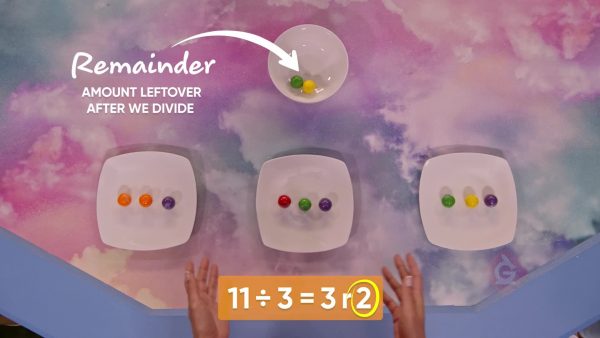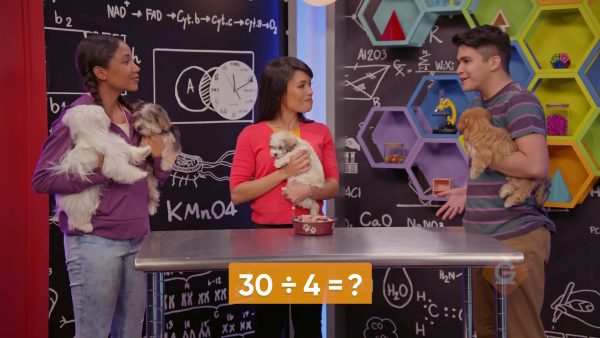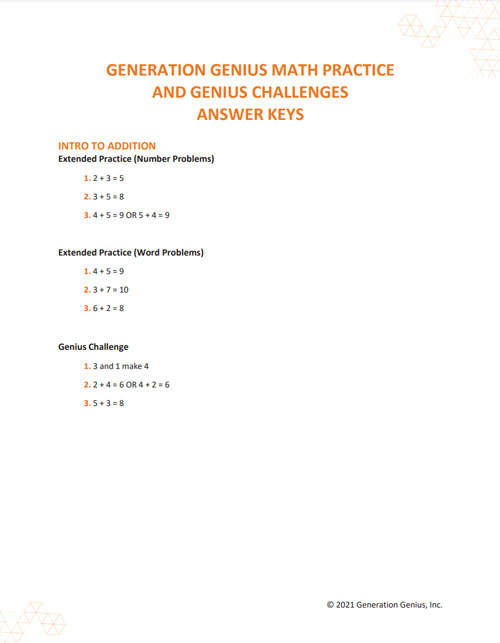Sometimes, when you divide objects into equal-sized groups, there are some left over. This amount is called the remainder. You need to think carefully about how to use the remainder to find answers to different problems.
To better understand remainders in a division problem…
LET’S BREAK IT DOWN!
Defining Remainders

If we have 12 gumballs and we want to divide them equally among 3 people, each person gets exactly 4 gumballs. If we have 11 gumballs and we want to divide them equally among 3 people, we only have enough gumballs to give each person 3. We then have 2 gumballs left over, which is not enough to divide equally among 3 people. These 2 gumballs are called the remainder. Then 11 divided by 3 is equal to 3 with a remainder of 2. Now you try: You want to divide 10 gumballs into 3 equal groups. How many does each group get? How many are left over?
When can we ignore the remainder?

You picked 26 apples and you want to make care packages that each contain 4 apples to give to your friends. How many packages of 4 whole apples can you make? We can make 6 groups of 4 apples, and there are 2 apples left over. Since we can’t put parts of apples in the care packages, we can ignore the remainder in this scenario. Now you try: A car fits 3 people. How many cars do you need to fit 17 people? Can you ignore the remainder?
When do we need to use the remainder?

Your whole grade is going to the Air and Space Museum. There are 120 students and teachers going. The school rents buses to transport them. If each bus holds 50 people, how many buses do we need? We need to divide 120 by 50. We can make two groups of 50 from 120, and there are 20 left over. Then 120 ÷ 50 = 2 with a remainder of 20. In this case, we can’t ignore the 20 leftover people. We need to round up and get 3 buses. The third bus won’t be full, but we need to make sure that everyone gets a ride. Now you try: The next grade up has 135 students and teachers going. How many buses would you need?
When is the remainder the answer?

You have 5 shelves and you want to display 44 trophies. Each shelf can fit 8 trophies. Are there any trophies that don’t fit on the shelves? We want to solve 44 ÷ 8. We can turn this into a multiplication problem by asking “8 times what number equals 44?” 8 × 6 = 48, which is too much, but 8 × 5 = 40, which is not enough. That means that if we have 5 shelves and each shelf fits 8 trophies, we can fit 40 trophies and we have 4 left over. In this case, the remainder is our answer: 4. Now you try: Sammie bakes a batch of 55 cookies. She puts as many as she can into boxes of 12. How many cookies are left over?
When can we split up the remainder?

You have 30 dog treats that you need to share equally among 4 dogs. To solve this division problem, we can ask, “4 times what is equal to or close to 30?” 4 × 8 = 32, which is too much, because we only have 30 treats. 4 × 7 is 28. That means that 30 divided by 4 is 7 with a remainder of 2. Each dog gets 7 whole treats, and there are 2 left over. In this case, we can split up the remaining 2 treats between 4 dogs using fractions. 4 ÷ = [ggfrac]1/2[/ggfrac], so each dog gets an extra [ggfrac]1/2[/ggfrac] of a treat! Then 30 ÷ 4 = 7[ggfrac]1/2[/ggfrac] with no remainder. Now you try: 14 liters of juice are divided evenly into 3 pitchers. How many liters does each pitcher get?

































































































































 Select a Google Form
Select a Google Form








